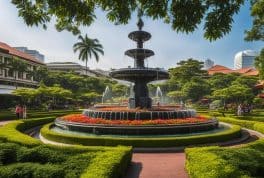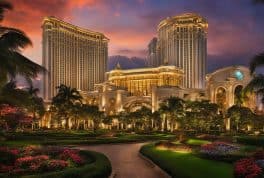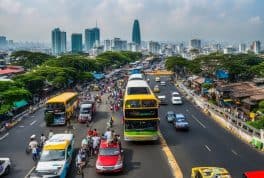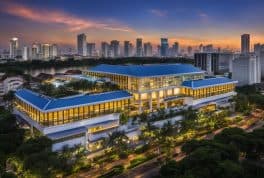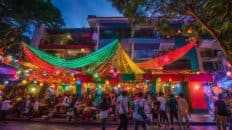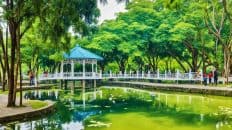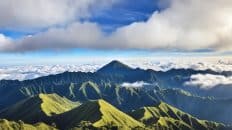Luzon Island
Luzon, the largest Philippine island, is a rich blend of natural wonders, from the perfect cone of Mayon Volcano to the ancient Banaue Rice Terraces. It's a cultural mosaic, with historic Intramuros, vibrant Manila, and diverse regional cuisines, embodying the Philippines' dynamic spirit and heritage.
Top 10 Things to see in Luzon
- Banaue Rice Terraces: These ancient terraces, carved into the mountains of Ifugao, are often referred to as the "Eighth Wonder of the World" for their sheer beauty and the ingenuity of their ancient builders.
- Intramuros, Manila: The historic walled city in Manila is a testament to the Philippines' Spanish colonial past, featuring historic structures like Fort Santiago and San Agustin Church.
- Mayon Volcano, Albay: Famous for its almost perfectly symmetrical cone shape, Mayon Volcano is a majestic sight and a popular spot for photography and adventure activities.
- Taal Volcano and Lake, Batangas: Known as one of the world's smallest active volcanoes, Taal Volcano offers a unique experience with its location on an island within a lake.
- Sagada, Mountain Province: Renowned for its hanging coffins, this tranquil mountain town also offers caving, trekking, and a chance to experience the rich culture of the indigenous people.
- Hundred Islands National Park, Pangasinan: A collection of 124 islands, many of which are ideal for snorkeling, swimming, and exploring, this national park is a haven for nature lovers and beachgoers.
- Vigan, Ilocos Sur: This UNESCO World Heritage site is famous for its preserved Spanish colonial and Asian architecture, cobblestone streets, and unique cultural heritage.
- Pagsanjan Falls, Laguna: Offering an adventurous boat ride through a scenic gorge, Pagsanjan Falls is one of Luzon's most famous waterfalls, surrounded by lush tropical forest.
- Mt. Pulag, Benguet: As the highest peak in Luzon, Mt. Pulag is known for its breathtaking sea of clouds and the stunning views it offers, especially at sunrise.
- La Union: While not as famous as some other spots, La Union has become a popular destination for its beaches, surfing spots, and a growing food and arts scene.
Guides and Tours
Cities on Luzon
- Quezon City
- Manila
- Caloocan
- Taguig
- Pasig
- Parañaque
- Valenzuela
- Las Piñas
- Makati
- San Jose del Monte
- Pasay
- Muntinlupa
- Calamba
- Mandaluyong
- Angeles
- Baguio
- Batangas City
- Lucena
- Antipolo
- Malabon
- Tagaytay
- Navotas
- San Juan
- Marikina
- Tarlac City
- Cabanatuan
- Olongapo
- San Fernando (Pampanga)
- Lipa
- Dagupan
- Tuguegarao City
- Legazpi City
Provinces on Luzon
- Abra
- Albay
- Apayao
- Aurora
- Bataan
- Batangas
- Benguet
- Bulacan
- Cagayan
- Camarines Norte
- Camarines Sur
- Catanduanes
- Cavite
- Ifugao
- Ilocos Norte
- Ilocos Sur
- Isabela
- Kalinga
- La Union
- Laguna
- Mountain Province
- Nueva Ecija
- Nueva Vizcaya
- Pampanga
- Pangasinan
- Quezon
- Quirino
- Rizal
- Sorsogon
- Tarlac
- Zambales

Top 10 Questions and Answers about Luzon
What is Luzon?
What are the major cities in Luzon?
What languages are spoken in Luzon?
What is the climate like in Luzon?
What are the key tourist attractions in Luzon?
What is the significance of Luzon in Philippine history?
What is the economy of Luzon like?
Are there any unique cultural practices in Luzon?
What are the main modes of transportation in Luzon?
What are some traditional dishes from Luzon?
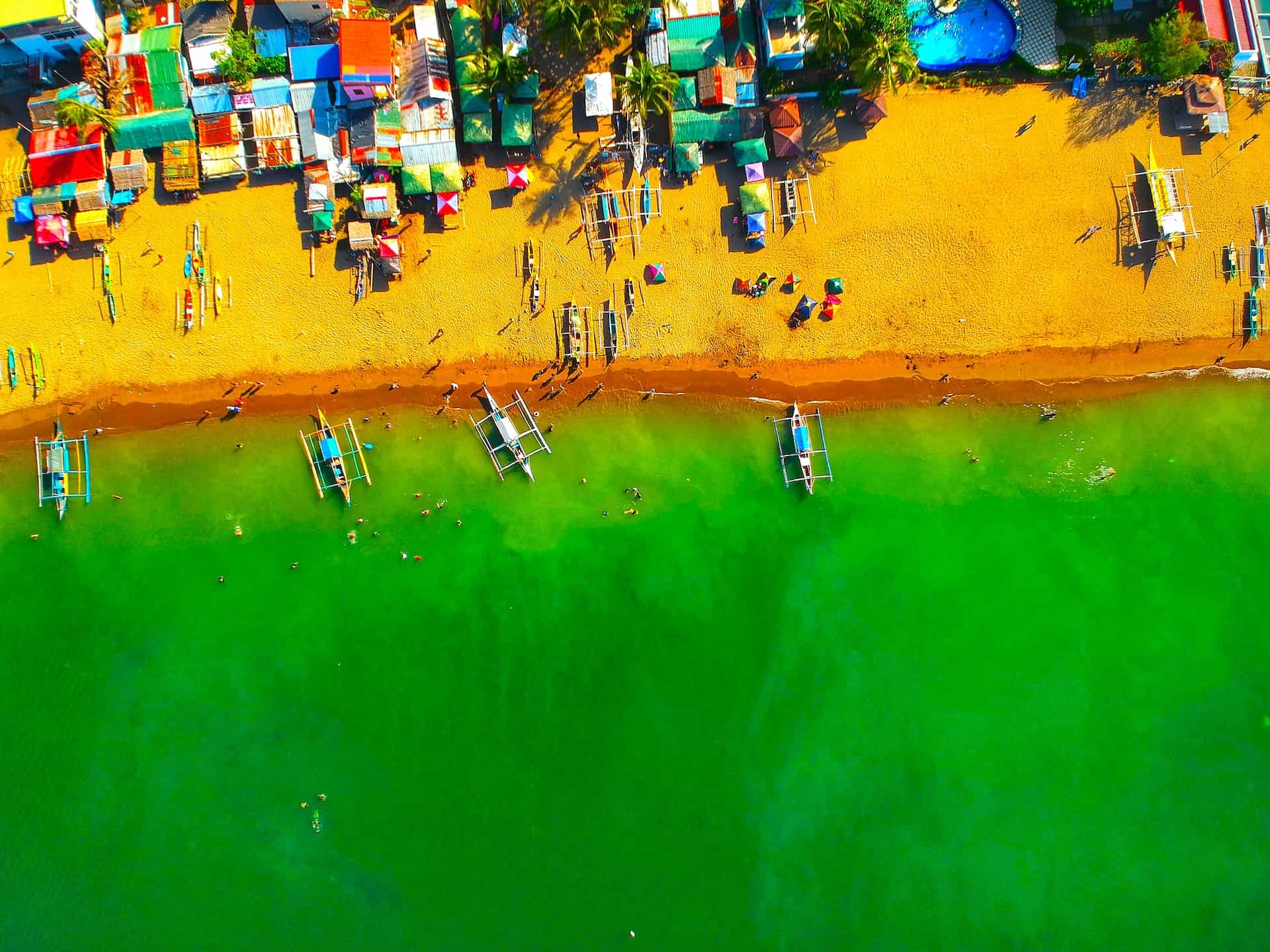
Why you should visit Luzon
Introduction: The Heart of the Philippines
Luzon, the largest island in the Philippines, is not just a destination; it's a vibrant experience waiting to unfold. With its rich history, diverse culture, and breathtaking landscapes, Luzon offers a journey like no other. From the bustling streets of Manila to the tranquil rice terraces of the north, each corner of Luzon tells a story that beckons to be discovered.
Historical Richness: A Walk Through Time
A visit to Luzon is incomplete without exploring its historical treasures. Intramuros, the walled city in Manila, is a living museum showcasing the Spanish colonial era with its ancient churches, forts, and cobblestoned streets. Further north, the city of Vigan in Ilocos Sur, a UNESCO World Heritage site, captivates with its well-preserved Spanish colonial and Asian architecture. These historical landmarks not only offer a glimpse into the past but also tell the story of Luzon's evolution.
Natural Splendors: Luzon’s Geographic Tapestry
Luzon’s natural beauty is as varied as its culture. The world-famous Banaue Rice Terraces, often referred to as the “Eighth Wonder of the World,” are a testament to ancient ingenuity. The majestic Mayon Volcano in Albay, known for its perfect cone shape, offers awe-inspiring vistas. Beach lovers will find paradise in the pristine shores of Batangas and La Union, while the mountainous regions of Baguio and the Cordilleras provide a cool retreat with stunning panoramic views.
Cultural Exuberance: Festivals and Traditions
The cultural vibrancy of Luzon is best experienced through its festivals. The Panagbenga Festival in Baguio City is a floral celebration that fills the streets with color and life. In Pampanga, the Giant Lantern Festival illuminates the night sky, showcasing the Filipino spirit of creativity and community. Each festival in Luzon is a kaleidoscope of music, dance, and tradition, offering a glimpse into the soul of the island.
Culinary Journey: A Taste of Luzon
Luzon's culinary landscape is as diverse as its geography. The region's traditional dishes, such as the hearty Bulalo of Batangas and the spicy Bicol Express, are a delight for food enthusiasts. In addition, the streets of Manila offer a fusion of international cuisines, reflecting the cosmopolitan nature of the island.
Adventure and Leisure: Activities for Every Traveler
For adventure seekers, Luzon presents endless possibilities. Surfing in the beaches of La Union, hiking the trails of Mount Pulag, or exploring the underground river in Palawan, Luzon caters to all kinds of adventurers. For those seeking relaxation, the island's numerous resorts and spas provide the perfect setting to unwind.
Manila: A Modern Metropolis with a Heart
Manila, the capital city, is a bustling metropolis that offers a mix of modernity and tradition. From shopping malls and entertainment centers to historic sites like Rizal Park and the National Museum, Manila is a city that never sleeps, offering experiences that cater to every interest.
Conclusion: Luzon, an Unforgettable Journey
Luzon, with its rich tapestry of experiences, is more than just a travel destination; it's a journey through history, culture, nature, and culinary delights. Whether it’s the warmth of its people, the beauty of its landscapes, or the richness of its heritage, Luzon leaves an indelible mark on every traveler. A trip to Luzon is not just a journey through a place, but a journey through the very essence of the Philippines.

Luzon Facts
1: Introduction to Luzon
"Luzon island group, the largest of three island groups in the Philippines, stands as a testament to the rich cultural and historical tapestry of the archipelago. Sprawled across a vast area, Luzon Island group is not just a geographic entity but a dynamic character in the Philippine narrative. From the rugged terrains of Northern Luzon to the bustling streets of Quezon City, this island group echoes tales of the past, whispers of the present, and dreams of the future. This introduction aims to encapsulate the essence of Luzon – an an island group, a home, a legacy.
The Geographical Majesty of Luzon
Encompassing a significant portion of the Philippines’ land area, Luzon is surrounded by the South China Sea to the west, the Luzon Sea to the east, and hosts numerous outlying islands. This main island group of Luzon comprises several regions, each distinct in its character. Northern Luzon, known for its mountainous and narrow region, presents a stark contrast to the relatively flat terrain outlying three outlying island provinces, three island groups, and outlying one island group of provinces, extending east from the south and central luzon plains. Southern Luzon, meanwhile, offers a blend of coastal charm and inland splendors.
Luzon Island, at its core, is an epitome of geographical diversity. From the serene beaches lining the South China Sea to the imposing mountain ranges of the Cordillera Central, Luzon’s landscapes are as varied as they are breathtaking. It’s this geographical diversity that makes Luzon a microcosm of the entire Philippine archipelago.
Historical Significance of Luzon
Delving into Luzon’s past, one encounters a history as vast and varied as its landscapes. The island was a crucial player during significant events, such as the establishment of the First Philippine Republic. Notably, the Luzon kingdoms resisted Islam, unlike other parts of the archipelago, contributing to the diverse religious tapestry of the region. This resistance was not a mere footnote in history; it shaped the cultural and religious landscape of Luzon.
The Spanish colonial era left indelible marks on Luzon. The architecture, language, and traditions of places like Quezon City and the province of Quezon are testaments to this period. Yet, the spirit of Luzon was never fully subdued. The Philippine Republic resisted foreign domination, and eventually, Luzon regained independence, a milestone that reshaped its destiny and that of the entire Philippine archipelago.
The Cultural Mosaic of Luzon
The cultural fabric of Luzon is a rich mosaic, influenced by its strategic geographical location in East Asia. The island has been a melting pot of indigenous, Asian, and Western influences. This blend is evident in the language, cuisine, and traditions that predominate in Luzon. The island has seen Chinese valued Luzon for trade and commerce, while neighboring Asian political entities have also left their mark.
Luzon’s major cities, especially Quezon City, are bustling centers of culture and commerce. These populous cities reflect the dynamic nature of modern Luzon, where tradition meets modernity. The city streets buzz with the energy of commerce, the arts, and technology, making Luzon the economic and political center of the Philippines.
Luzon’s Geopolitical and Economic Role
Luzon plays a pivotal role in the geopolitics and economy of the Philippines and Southeast Asia. As the country’s largest producer of agricultural and industrial goods, it drives national development. The administrative region of Luzon, particularly the National Capital Region, is the hub of governmental and commercial activities. The Philippine Statistics Authority and the National Statistical Coordination Board have highlighted Luzon’s contribution to the national economy, underscoring its importance.
Moreover, Luzon’s location has made it a strategic point in East Asia. The island group has been instrumental in the Philippines' interactions with neighboring countries. Its ports and cities have facilitated trade and cultural exchanges, making Luzon a gateway to East and Southeast Asia.
The Environmental and Natural Wealth of Luzon
*Luzon island is also a treasure trove of natural wonders. The Cordillera Central Mountain Ranges and the Sierra Madre provide a haven for biodiversity and are home to numerous endemic species. These mountain ranges, along with the East Luzon Trench, contribute to the island’s unique ecological makeup. The Philippine Territorial Waters surrounding Luzon are rich in marine life, adding to the island’s environmental significance.
The massive prehistoric volcano situated in Southern Luzon is a reminder of the island’s geological history. These natural features not only shape Luzon’s landscape but also play a crucial role in the lives of its inhabitants, influencing their livelihoods, culture, and traditions.
Luzon in the Filipino Consciousness
"Luzon island is more than just a geographical entity; it is a symbol of Filipino identity and resilience. The struggles and triumphs of Luzon mirror those of the entire Philippine archipelago. From resisting colonial forces to striving for economic and political autonomy, Luzon’s narrative is interwoven with the broader story of the Philippines.
As we delve deeper into the facets of Luzon in the following sections, we will explore its regional diversity, historical significance, cultural richness, and its role in shaping the destiny of the Philippines. Luzon is not only a part of the Philippine archipelago; it is a central character in the country’s ongoing story – a story of diversity, resilience, and hope.
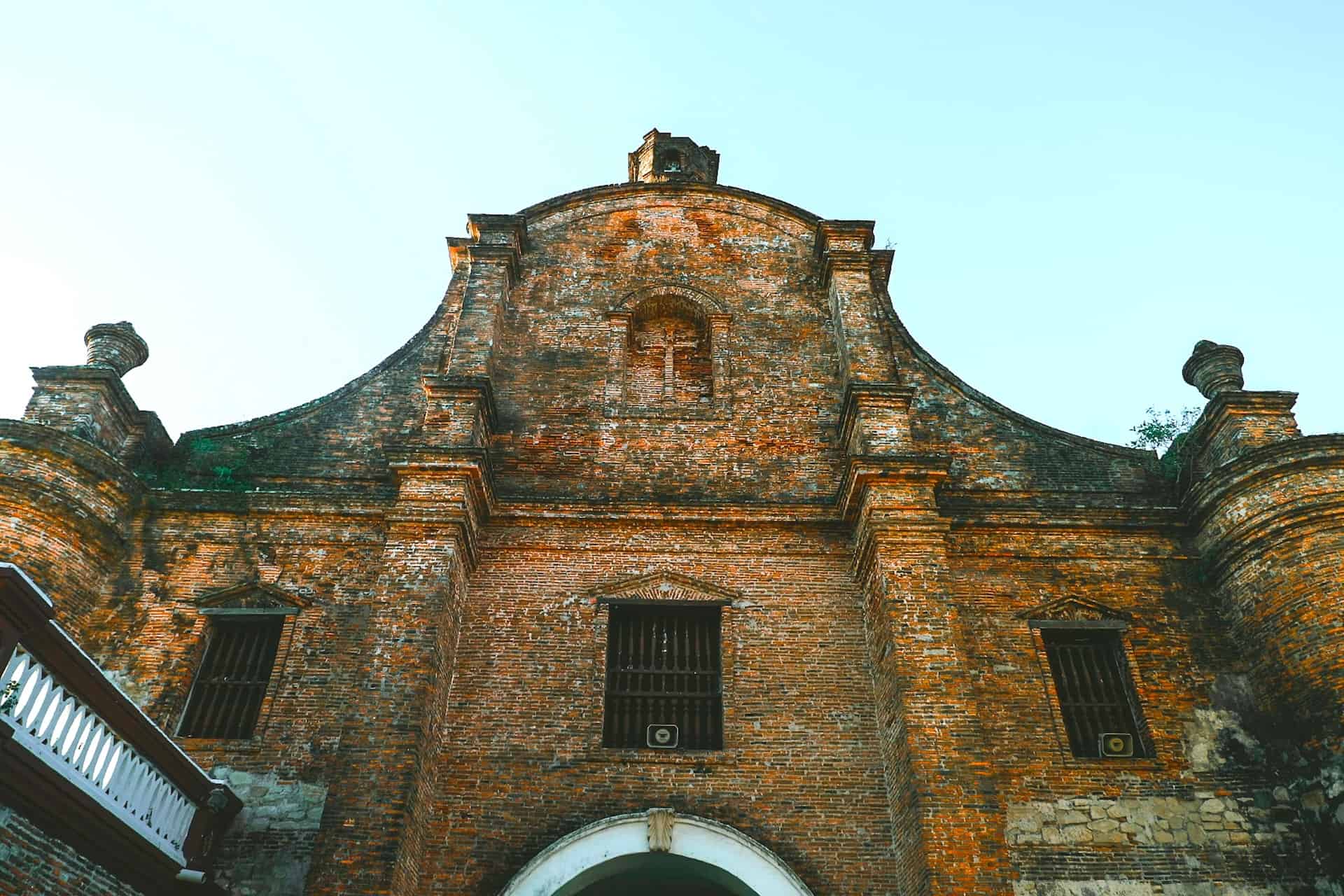
2: Geographical Layout and Regions of Luzon
Luzon, the largest and most populous island in the Philippine archipelago, is a land of extraordinary diversity. Its geographical features range from expansive plains and fertile valleys to towering mountain ranges and rugged coastlines. This section delves into the distinct regions of Luzon – Northern Luzon, Central Luzon, and Southern Luzon – each boasting its unique topographical characteristics and cultural identity.
Northern Luzon: A Land of Mountains and Valleys
Northern Luzon is renowned for its mountainous and narrow region, home to the famous Cordillera Central mountain ranges. This area is characterized by steep, rugged terrain and is known for its breathtaking landscapes and rich indigenous cultures. The mountains of Northern Luzon are not just geographical features but are deeply intertwined with the cultural identity of the people living there. The rice terraces of the Cordillera, carved into these mountainsides, are a testament to the ingenuity and perseverance of the indigenous communities.
The region is also home to the Cagayan Valley, a vast expanse of fertile land that stretches from the mountains to the sea. This valley, encompassed within Region II, is an agricultural powerhouse, contributing significantly to Luzon's status as the country's largest producer of crops. The Cagayan River, the longest and widest river in the Philippines, meanders through this valley, nourishing the land and sustaining livelihoods.
Central Luzon: The Rice Bowl of the Philippines
Central Luzon, often referred to as the rice bowl of the Philippines, is a testament to the island’s agricultural wealth. This region, encompassing provinces like Pampanga and Tarlac, is characterized by its flat terrain extending east, creating an ideal landscape for large-scale rice production. The region's importance in the country's food security cannot be overstated, as it supplies a significant portion of the Philippines' rice needs.
The strategic geographical location of Central Luzon has also made it a hub for commerce and industry. The region is crisscrossed by major transportation networks, connecting it to other parts of Luzon and the rest of the Philippines. The development of infrastructure in Central Luzon has been a key factor in driving economic growth in the region and the island as a whole.
Southern Luzon: A Mosaic of Landscapes and Cultures
Southern Luzon, comprising the southern and island provinces, such as Laguna, Batangas, and Quezon, offers a diverse range of landscapes from volcanic hills to serene beaches. The region is home to Laguna de Bay, the largest lake in the Philippines, which plays a significant role in the region's ecology and economy. The southern and southeastern portion of Luzon also boasts the majestic Mount Banahaw, a volcano revered as a holy mountain by local communities.
The cultural landscape of Southern Luzon is as varied as its physical one. The region is a melting pot of indigenous, Spanish, and Asian influences, evident in its festivals, architecture, and cuisine. The province of Quezon, for instance, reflects this cultural blend, hosting vibrant festivals that draw visitors from across Luzon and beyond.
Eastern, Western, and Southeastern Luzon: Coastal Charms and Untouched Beauty
Eastern Luzon, facing the Pacific Ocean, is known for its picturesque beaches and rich marine biodiversity. The Eastern Luzon Trench, an underwater formation, adds to the region's ecological significance. Meanwhile, Western Luzon, along the coast of the South China Sea, has played a vital role in the island’s history as a gateway for trade and cultural exchanges.
Southeastern Luzon, often overshadowed by more prominent regions, boasts a tranquil charm with its unspoiled beaches and rolling hills. This region is a hidden gem, offering a glimpse into Luzon’s natural beauty away from the bustling cities.
Luzon's Islands: A World of Their Own
Beyond mainland Luzon lie numerous outlying islands, each with its unique allure. These islands, part of the Luzon Island Group, range from popular tourist destinations to remote, untouched paradises. They play a crucial role in the biodiversity and ecological balance of Luzon. The waters surrounding these islands, part of the Philippine Territorial Waters, are teeming with marine life, making them important fishing grounds and ecological havens.
Luzon’s Varied Terrain and Its Impact on Life
The diverse geography of Luzon has a profound impact on the lives of its inhabitants. From the Cordillera Central mountain ranges to the flat plains of Central Luzon, the terrain has shaped the culture, economy, and history of the island. The mountainous regions have fostered unique highland cultures, while the fertile plains have been the backbone of Luzon’s agricultural economy.
In conclusion, Luzon’s geographical layout is not just a feature of the land but a canvas that tells the story of its people. From the mountainous and narrow region of the Northern portion of Luzon to the lush plains of Central Luzon and the diverse landscapes of the Southern portion of Luzon, each area contributes to the rich tapestry that is Luzon. As we explore further in the upcoming sections, the intricate relationship between Luzon’s geography and its cultural, historical, and economic narratives will become even more apparent. This island, with its varied regions and terrains, is a living, breathing entity – a central character in the unfolding story of the Philippines.
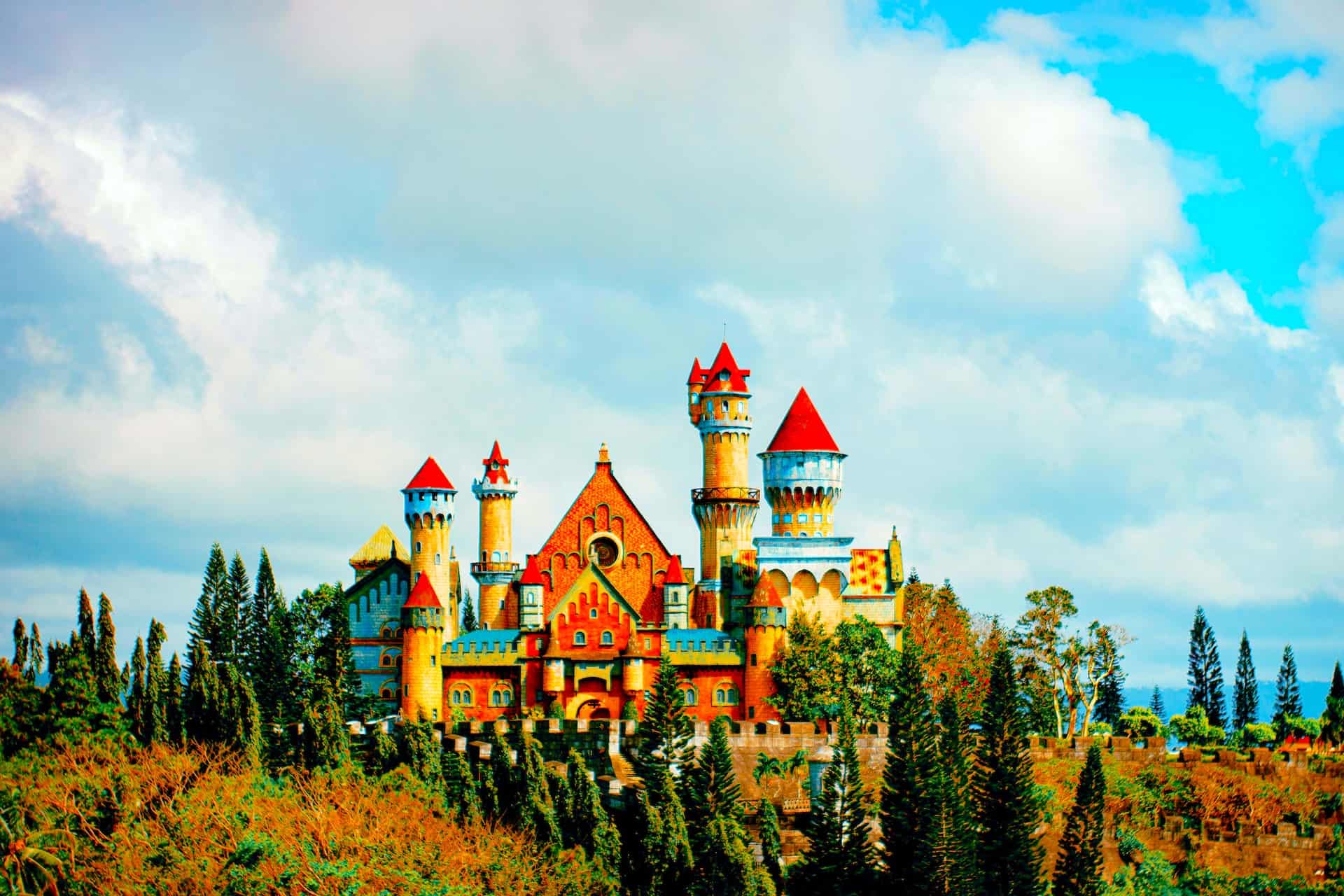
3: Historical Context of Luzon
Luzon, the Philippines' largest island, is not just a geographical marvel but also a repository of the nation's rich history. From the era of the First Philippine Republic to the present day, Luzon has played a pivotal role in shaping the Filipino identity. This section delves into the historical significance of Luzon, revealing how its past has influenced its present and future.
The First Philippine Republic and Luzon’s Role
The First Philippine Republic, established towards the end of the Spanish colonial era, marked a significant chapter in Luzon's history. It was in Malolos, Bulacan, a province in Central Luzon, where the Malolos Constitution was drafted, giving birth to the first democratic republic in Asia. This event underscored Luzon’s central role in the Filipino struggle for independence. The island was not just a battleground for freedom but also a cradle of emerging Filipino nationalism.
Luzon’s Resistance to Colonial and Religious Conquest
Historically, Luzon has been a bastion of resistance. The Luzon kingdoms resisted Islam, which was spreading through other parts of the archipelago from the islands to the north and southern islands to the north. This resistance molded a unique cultural and religious landscape in Luzon, differentiating it from other regions in the Philippines.
During the Spanish colonial era, Luzon became the administrative and religious center of the Spanish East Indies. Cities like Manila and Quezon City (then a part of the province of Rizal) were pivotal in the colonial administration. However, even under Spanish rule, Luzon was a hotbed of revolutionary activities. Filipino revolutionaries in Luzon played a crucial role in resisting Spanish occupation, eventually leading to the Philippine Revolution and the establishment of the Philippine Republic.
Luzon’s Struggle for Independence
The struggle for independence in Luzon was multifaceted. It was not just against foreign dominion but also a fight for cultural and political identity. The Chinese, who valued Luzon for trade, left a lasting impact on its culture and economy. However, the most transformative period was arguably the Spanish occupation, which introduced Christianity, new governance systems, and cultural practices.
Despite these influences, Luzon retained its unique identity. The Philippine Republic resisted the Spanish, American, and Japanese occupiers at various times in history. The resilience and spirit of resistance in Luzon were instrumental in regaining Philippine independence. This era also saw significant developments in Luzon’s social and political landscape, with cities like Quezon City emerging as centers of power and influence.
Luzon in the Post-Independence Era
After the Philippines gained independence, Luzon transitioned from a colonial outpost to the center of a sovereign nation. The island played a critical role in the reconstruction and development of the post-war Philippines. Luzon’s strategic geographical location in East Asia continued to influence its political and economic interactions with neighboring countries.
The rise of new political entities in Luzon, such as the National Statistical Coordination Board and the National Statistics Office, reflected the island’s growing importance in national governance and planning. The economic and political center of the Philippines gradually shifted to Luzon, particularly to the areas surrounding Manila.
Luzon’s Cultural Evolution
The cultural landscape of Luzon evolved significantly over the centuries. From the indigenous tribes of the southern Cordillera mountains and Central mountain ranges to the mestizo communities in cities like Quezon City and Manila, Luzon became a melting pot of cultures. The province of Quezon, named after the second President of the Philippines, Manuel L. Quezon, is a reflection of this cultural diversity.
Luzon’s history is a narrative of resilience and transformation. From resisting colonial powers to shaping the destiny of a nation, Luzon has been at the forefront of the Filipino story. As we delve deeper into Luzon’s socio-economic and cultural aspects in the following sections, the enduring impact of its historical journey will become increasingly apparent. Luzon is not just a part of the Philippine archipelago; it is a testament to the enduring spirit of the Filipino people – a spirit of resistance, resilience, and hope.
4: Political and Administrative Divisions of Luzon
Luzon, the crown jewel of the Philippine archipelago, is not only a land of diverse landscapes but also a tapestry of various political and administrative divisions. Each region, from Region II in the north to Region III in Central Luzon, contributes uniquely to the island's rich cultural and political narrative. This section explores these divisions, focusing on their impact on Luzon's socio-economic fabric.
Region II: The Northern Gateway
Region II, also known as the Cagayan Valley, is a pivotal area in Northern Luzon. This region is characterized by its agricultural prowess, primarily fueled by the fertile lands of the Cagayan River basin. The strategic location of Region II has made it an important trade and cultural link between Luzon and its northern neighbors. The administrative prowess of this region contributes significantly to Luzon's overall governance and development.
Central Luzon: The Heartland of Politics and Agriculture
Central Luzon, often referred to as Region III, is the hub of political and economic activity in Luzon. This region is home to several provinces, including the populous and historically significant province of Pampanga. Central Luzon's flat terrain has made it an agricultural powerhouse, complementing the mountainous and narrow region of Northern Luzon. The region's contribution to Luzon's food security and economic stability cannot be overstated.
The Administrative Region of the National Capital
The National Capital Region (NCR), predominantly encompassing Metro Manila and its surrounding areas, including Quezon City, is the administrative and political heart of Luzon and the Philippines. The NCR's role extends beyond administration; it is the cultural, economic, and political center, influencing policies and trends across Luzon and the entire country.
Quezon City: A Microcosm of Luzon’s Diversity
Quezon City, formerly a part of Rizal Province, is a microcosm of Luzon’s diversity. As one of the most populous cities in the Philippines, it reflects the dynamic blend of cultures, economies, and political ideologies that characterize Luzon. The city’s development over the years mirrors the growth and challenges faced by Luzon as a whole.
The Cordillera Administrative Region: Preserving Indigenous Heritage
The Cordillera Administrative Region in Northern Luzon is a unique addition to the island's political landscape. This region is home to the Cordillera Central mountain ranges and a rich tapestry of indigenous cultures. The creation of this administrative region was a significant step in recognizing and preserving the unique heritage and autonomy of the indigenous communities in Luzon.
Luzon’s Role in National Governance
Luzon's political divisions, from the bustling cities of the National Capital Region to the agricultural heartlands of Central Luzon and the culturally rich Cordillera Administrative Region, play a crucial role in the governance and development of the Philippines. The island's administrative regions are not just political entities; they are vibrant communities with distinct identities contributing to the tapestry of Luzon.
In conclusion, the political and administrative divisions of Luzon are a testament to the island's complexity and significance. From the governance hubs in Region III to the cultural strongholds in the Cordillera, each area contributes uniquely to the narrative of Luzon. As we delve deeper into Luzon's socio-economic and cultural aspects in the following sections, the impact of these divisions on the island's development and identity will become increasingly apparent. Luzon, with its diverse regions and communities, stands as a beacon of the Filipino spirit – a spirit of unity in diversity.
5: Natural Features and Environment of Luzon
Luzon, the Philippine archipelago's largest island, is a natural wonderland, boasting a wide array of ecological and geological features. From the majestic Cordillera Central mountain ranges to the serene waters of the Luzon Sea, the island's natural environment is as diverse as it is stunning. This section explores the richness of Luzon's natural landscape and its significance to the island's ecological balance and cultural heritage.
The Cordillera Central Mountain Ranges: A Haven of Biodiversity
Dominating Northern Luzon, the Cordillera Central mountain ranges are not only a geographical landmark but also an ecological treasure. These mountains are home to a myriad of species, many of which are endemic to the Philippines. The rugged terrain and varying climates of the Cordillera Central have created unique habitats that support diverse flora and fauna. This region is a testament to Luzon's role in the conservation of biodiversity.
The East Luzon Trench: A Marine Marvel
The East Luzon Trench, an underwater formation off the eastern coast, adds another layer to Luzon's ecological significance. This deep-sea trench is crucial for marine research and is believed to influence the climate and ocean currents around Luzon. The waters surrounding this trench, part of the Philippine Territorial Waters, are a hotspot for marine biodiversity, contributing to Luzon's status as an ecological powerhouse.
Laguna de Bay: A Lifeline for Southern Luzon
In Southern Luzon, Laguna de Bay stands as the largest lake in the Philippines. This lake is not only a vital source of freshwater but also plays a central role in the region's agriculture and fisheries. The communities surrounding Laguna de Bay have a symbiotic relationship with it, relying on its waters for livelihood and sustenance.
The Luzon Sea and Outlying Islands: A Network of Life
The Luzon Sea, which borders Luzon to the east, along with the outlying islands, forms a complex ecosystem. These waters are teeming with marine life, providing vital resources for the fishing communities in Luzon. The province outlying islands in the Luzon Sea, though smaller and less populated than Luzon itself, are integral to the ecological and cultural fabric of the region.
Luzon's Volcanic Legacy: A Story of Fire and Life
The geological history of Luzon is marked by volcanic activity. The island hosts several volcanoes, including the massive prehistoric volcano in Southern Luzon. These volcanoes have shaped the island's landscape, creating fertile soils that support Luzon's lush vegetation and agriculture. The volcanic activity has also been a part of Luzon's cultural narrative, with many communities holding traditional beliefs and stories about these fiery giants.
Luzon's Environment: Challenges and Conservation
Luzon faces significant environmental challenges, including deforestation, pollution, and the impact of climate change. The conservation of Luzon's natural environment is crucial, not only for the island's ecological health but also for the well-being of its inhabitants. Efforts to preserve the Cordillera Central mountain ranges, protect the marine life in the Luzon Sea, and sustainably manage resources like Laguna de Bay are essential for the future of Luzon.
In conclusion, the natural features and environment of Luzon are central to the island's identity and sustainability. From the towering Cordillera Central to the depths of the East Luzon Trench, each element of Luzon's natural landscape plays a vital role in the ecological and cultural narrative of the island. As we move forward, it is imperative to recognize and protect the natural beauty and richness of Luzon, ensuring that it continues to be a haven of biodiversity and a source of life for future generations.
6: Socio-economic Aspects of Luzon
Luzon, as the economic and political powerhouse of the Philippines, showcases a complex tapestry of socio-economic dynamics. From being the country's largest producer in various sectors to hosting its most populous cities, Luzon stands as a testament to the Philippines' growth and challenges. This section delves into the socio-economic landscape of Luzon, exploring its role in the nation's development and the lives of its inhabitants.
Luzon: The Economic Engine of the Philippines
Luzon's role as the economic backbone of the Philippines cannot be overstated. It is the country's largest producer of agricultural goods, industrial products, and services. The central plains of Luzon, particularly in regions like Central Luzon and Southern Luzon, are agricultural hotspots, contributing significantly to the nation’s food supply. The industrial sectors, predominantly located in and around Metro Manila and other urban areas like Quezon City, drive the nation's economic growth.
Urbanization and Its Effects in Luzon
The urban landscape of Luzon, especially in the National Capital Region, reflects the rapid urbanization that the island has undergone. Quezon City, one of the most populous cities in Luzon, epitomizes this urban growth. The areas surrounding Manila have seen a surge in population, businesses, and infrastructural development, making Luzon the economic and political center of the Philippines.
Cultural Diversity and Its Economic Impact
Luzon's socio-economic fabric is enriched by its cultural diversity. The island is home to a multitude of ethnic groups, languages, and traditions, which have shaped its economic and social structures. In places like the Cordillera Administrative Region and the provinces of Central Luzon, this diversity is evident in the unique crafts, festivals, and tourism attractions that contribute to Luzon's economy.
Challenges and Opportunities in Luzon’s Development
While Luzon leads in economic and political arenas, it also faces significant challenges. Issues like income disparity, urban congestion, and environmental degradation are prevalent. However, these challenges also present opportunities for sustainable development, innovative urban planning, and inclusive economic policies that can further strengthen Luzon's role as a leader in the Philippines.
Luzon's Role in National and Regional Economies
Luzon's influence extends beyond its shores, impacting national and regional economies. Its strategic geographical location in East Asia makes it a crucial player in regional trade and diplomacy. Luzon's ports and cities serve as gateways for international trade, making it a key contributor to the Philippines' interactions with neighboring Asian political entities.
In conclusion, the socio-economic aspects of Luzon paint a picture of a region that is dynamic, diverse, and central to the Philippines' story. From its agricultural fields to its bustling cities, Luzon embodies the challenges and aspirations of a nation on the rise. As we explore further in the subsequent sections, the intricate interplay between Luzon's socio-economic landscape and its cultural and environmental aspects will become increasingly evident. Luzon is not just a geographic entity; it is the heartbeat of the Filipino nation.
7: Demographics and Culture of Luzon
Luzon, the Philippine archipelago's largest island, is a melting pot of diverse cultures and demographics. This section explores the rich tapestry of ethnic groups, languages, and traditions that define Luzon's cultural landscape, contributing to its unique identity within the Philippines and Southeast Asia.
Ethnic Diversity and Languages of Luzon
Luzon's demographic composition is as varied as its landscape. Home to numerous ethnic groups, each with their distinct traditions and languages, Luzon is a vibrant mosaic of cultural diversity. The major groups that predominate Luzon include Tagalogs, Ilocanos, Kapampangans, and Bicolanos, among others. This diversity is also reflected in the major regional languages spoken across Luzon, contributing to the island’s rich linguistic heritage.
Cultural Practices and Traditions in Luzon
The cultural practices in Luzon are a fusion of indigenous, Spanish, and Asian influences. The festivals, arts, and culinary traditions across Luzon display a blend of these influences. From the colorful Pahiyas Festival in the mountain province out of Quezon province to the grandiose Christmas celebrations in Quezon City, Luzon’s festivals are a vibrant expression of its cultural diversity.
Urban Centers and Population Dynamics
Luzon hosts some of the Philippines' most populous cities, including the bustling metropolis of Quezon City. The urban centers of Luzon are not just economic hubs but also melting pots of cultures, where traditional practices meet modern influences. The population dynamics in these cities, influenced by migration and urbanization, add to the complexity of Luzon's demographic profile.
The Role of the Philippine Statistics Authority
The Philippine Statistics Authority plays a crucial role in understanding Luzon's demographic and cultural landscape. Through census data and research, the Authority provides insights into the population trends, ethnic composition, and cultural shifts occurring across Luzon, helping to shape policies and initiatives that cater to the diverse needs of its inhabitants.
Cultural Heritage and Preservation in Luzon
Preserving the cultural heritage of Luzon is of paramount importance. In regions like the Cordillera Administrative Region, efforts are made to protect the indigenous cultures and traditions. Similarly, in Central Luzon and Southern Luzon, there are initiatives to preserve historical sites, traditional crafts, and local languages, ensuring that Luzon’s cultural legacy is passed down to future generations.
In conclusion, the demographics and culture of Luzon are integral to understanding the island's identity and its role in the broader narrative of the Philippines. From the ethnic diversity of its rural communities to the cultural melting pot of its urban centers, Luzon stands as a testament to the rich cultural heritage of the Filipino people. As we continue to explore Luzon in the subsequent sections, the intricate relationship between its people, culture, and history will become even more apparent, painting a full picture of this magnificent island.
8: Luzon in Global Context
Luzon, as the largest island in the Philippines, holds a position of significant strategic and cultural importance not only within the country but also in the broader context of East Asia. This section examines Luzon's role in international relations, trade, and cultural exchanges, highlighting its strategic geographical location and its influence in the Southeast Asian region.
Strategic Geographical Location in East Asia
Luzon's location at the northern tip of the Philippines has historically positioned it as a strategic gateway between East and Southeast Asia. This strategic geographical location has facilitated Luzon’s engagement in regional trade, politics, and cultural exchanges. The waters surrounding Luzon, including the South China Sea and the Luzon Sea, have been vital maritime routes for centuries, connecting the whole island group to neighboring Asian political entities.
Luzon’s Economic and Political Influence
As the economic and political center of the Philippines, Luzon exerts considerable influence in the Southeast Asian region. Home to the country's capital, Manila, and other major cities such as Quezon City, Luzon is the hub of the nation's political decision-making and economic activities. This has implications not only luzon not just for domestic policies but also for the Philippines' foreign relations and regional collaborations.
Cultural Exchanges and Diplomacy
Luzon island's cultural heritage, influenced by indigenous, Spanish, Asian, and American legacies, has made it a vibrant center for cultural exchanges. The island has welcomed traders, diplomats, and visitors from various parts of Asia and beyond, each leaving their imprint and taking back a piece of Luzon's rich cultural tapestry. This exchange has enriched Luzon’s cultural identity and has fostered mutual understanding and cooperation with other nations.
Luzon and Regional Trade
Luzon's role in regional trade cannot be understated. As the Philippines' primary economic driver, Luzon is a key player in the ASEAN economic community. Its ports handle a significant portion of the country's imports and exports, connecting the Philippines to global markets. Luzon's agricultural and industrial outputs are crucial not only for domestic consumption but also for international trade.
Environmental and Geopolitical Challenges
Luzon's strategic location also brings environmental and geopolitical challenges. Issues such as territorial disputes in the South China Sea and the impact of climate change on Luzon's coastlines and natural resources are of significant concern. Addressing these challenges requires regional cooperation and sustainable policies, underlining Luzon's role in shaping Southeast Asia's environmental and political landscape.
In conclusion, Luzon's role in the global context is multifaceted, encompassing economic, political, cultural, and environmental dimensions. Its strategic location in East Asia, combined with its rich cultural heritage and economic prowess, positions Luzon as a key player in regional and international affairs. As we move forward, Luzon's continued engagement and cooperation with neighboring countries will be crucial in addressing shared challenges and seizing opportunities in the dynamic landscape of Southeast Asia.
9: Luzon’s Role in Philippine History and Identity
Luzon, the Philippine archipelago's largest island, has been more than just a landmass; it has been a central figure in the nation's history and a crucial shaper of its identity. This section explores how Luzon has influenced the course of Philippine history, its role in the formation of national identity, and its contributions to the resilience and spirit of the Filipino people.
The Birthplace of the Philippine Republic
Luzon island's significance in Philippine history is highlighted by its role in the establishment of the First Philippine Republic. This historical event, which marked the first instance of democratic rule in Asia, was primarily centered in Luzon. The island was not only the geographical setting for this groundbreaking development but also the cultural and political heartland where the aspirations for a Filipino nation took shape.
Resistance and Independence Movements
Throughout its history, Luzon has been a hotspot for resistance against foreign invaders. The resistance movements in Luzon, especially during the Spanish occupation, were pivotal in shaping the island's, and consequently the country's, quest for independence. Notable events in Luzon, such as the Katipunan movement and the Philippine Revolution, laid the groundwork for the eventual liberation of the entire archipelago.
Cultural Intersection and Diversity
Luzon island's rich cultural tapestry, influenced by indigenous, Spanish, Asian, and American cultures, has contributed significantly to the formation of the Filipino identity. The luzon island's diverse cultural influences are evident in its traditions, languages, and arts. Luzon, especially in its populous cities like Quezon City, reflects the dynamism and diversity of the Filipino culture.
Economic Development and Modernization
As the country's economic and political center, Luzon has been instrumental in the Philippines' journey towards modernization and development. The growth of urban centers, industrialization, and the advancement of infrastructure in Luzon have played significant roles in shaping the economic landscape of the country.
The Role of National Institutions
The establishment of national institutions such as the National Statistical Coordination Board and the National Statistics Office in Luzon underscores the island's role in national governance and planning. These institutions, based in Luzon, are crucial in crafting policies that address the needs and aspirations of the Filipino people.
Challenges and Resilience
Luzon's history is also marked by challenges, including natural disasters, political upheavals, and social strife. However, these challenges have only strengthened the resilience of its people. Luzon's ability to overcome adversity has been a source of inspiration for the entire nation, reinforcing its role as a symbol of Filipino resilience.
In conclusion, Luzon’s influence on Philippine history and identity is profound and far-reaching. From being the birthplace of the nation's first republic to shaping its modern socio-economic landscape, Luzon has been at the heart of the Filipino narrative. As we continue to delve into the multifaceted aspects of Luzon in the next sections, its significance as the cornerstone of the Filipino spirit – a spirit of resilience, unity, and hope – becomes increasingly clear.
10: Conclusion
As we conclude our extensive exploration of Luzon, it's clear that this island is much more than just a geographical entity in the Philippine archipelago. Luzon is a living, breathing heart of the nation, pulsating with history, culture, diversity, and economic vitality. This final section encapsulates the essence of Luzon, highlighting its enduring importance and the prospects for its future.
Luzon: The Heart of the Philippines
Luzon, throughout its history, has played a pivotal role in shaping the destiny of the Philippines. From its strategic geographical location in East Asia to its status as the country's largest producer of agricultural and industrial goods, Luzon stands as a testament to the strength and resilience of the Filipino spirit. The island's diverse landscapes, from the mountainous regions of Northern Luzon to the fertile plains of Central Luzon and the vibrant cities like Quezon City, mirror the diversity of the Filipino people.
The Cultural and Historical Legacy of Luzon
The rich tapestry of Luzon’s culture and history is a source of pride for the Filipino nation. The island has been a crucible of historical events, from the resistance against colonial powers to the formation of the First Philippine Republic. The cultural influences from indigenous, Spanish, Asian, and American interactions have created a unique blend that defines Luzon's identity.
Luzon's Role in Shaping the Future
Looking forward, Luzon continues to be central to the Philippines' aspirations and challenges. As the economic and political center of the nation, the decisions and developments that unfold on Luzon will have a significant impact on the entire country. The challenges of urbanization, environmental sustainability, and social equity are areas where Luzon can lead by example.
Preserving Luzon’s Environment and Heritage
The conservation of Luzon's natural environment and cultural heritage remains a priority. Efforts to protect the Cordillera Central mountain ranges, the biodiversity of the Luzon Sea, and the historical landmarks across the island are crucial in maintaining Luzon's ecological balance and cultural richness.
Embracing Diversity and Unity
Luzon's story is not just about its landscapes or historical milestones; it's about its people. The island exemplifies the diversity and unity of the Filipino people. The blend of cultures, languages, and traditions in Luzon is a testament to the nation's capacity for harmony and inclusivity.
In conclusion, Luzon is not only a part of the Philippines; it is a central character in the nation's ongoing narrative. Its landscapes, people, history, and culture are interwoven into the fabric of Filipino life. As we look to the future, Luzon, with all its diversity and dynamism, will undoubtedly continue to play a key role in the journey of the Philippines. Luzon is not just an island; it is the embodiment of the Filipino dream – a dream of progress, unity, and enduring strength.
Sources: https://en.wikipedia.org/wiki/Luzon

